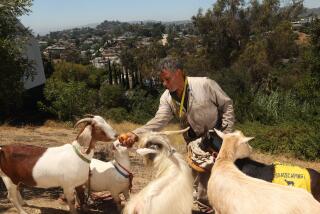Catalina Island Conservancy Resumes Killing Wild Goats
- Share via
Caretakers of rugged Santa Catalina Island have renewed the controversial hunting and killing of nonnative goats remaining on the island after a recent effort captured about 120 alive and moved them to munch grass on the mainland.
Outraging animal activists, officials of the Catalina Island Conservancy said they resumed the shootings last week because further live captures would take too long. Island officials estimated that 63 goats were killed last week and that the remaining 20 or so would be eradicated this week in a campaign to protect the delicate environment of brushy hills from the voracious animals.
The conservancy, which owns all but a sliver of Catalina, operates under a mandate to return the island to its natural state. Its leaders say that the goats’ eating habits threaten native plant life and the stability of the cliffs and that the goats consume food that should go to native animals. The conservancy also is trying to do away with nonnative pigs.
News of the renewed goat hunts brought harsh words from animal activists like Bill Dyer, a Venice resident and field representative for In Defense of Animals. Dyer, who raised $25,000 for the live-capture program conducted in October and November, had urged the conservancy to invite the goatherds back to round up and move the rest of the herd.
Dyer said the conservancy was “callous and cruel” to resume the hunts. “I don’t understand why they’d do this,” he said. “It’s the Catalina killing fields over there, it’s the island of death.”
Bill Bushing, a conservancy vice president, said that the live-capture program was partly successful but that the island’s goat population is about to increase again. He said the conservancy is worried that the goat herd would totally rebound to make up for its losses.
Goats had been shot, sometimes from helicopters, at various times in the past few years. But conservancy officials last year halted the killings and allowed what turned out to be the first successful live-capture program.
Goatherds from the Northern California organization Goats R Us camped on the island and snared more than 120 goats, chasing them on foot and roping them. The animals subsequently were shipped and then trucked to the San Francisco Bay Area, where they are used to clear brush fire fuel.
Although the conservancy offered Goats R Us a chance to resume its work in December, Dyer said it was financially and logistically impossible. Dyer couldn’t raise the necessary cash that fast, and Goats R Us had other commitments.
Dyer said the conservancy added insult to injury when it later declined an offer from an anonymous donor who pledged to fund another live-capture safari.
On Tuesday, Bushing said the board declined that offer because it would have involved further delays in removing the goats.
“The board is pretty strong and determined to bring this fully to an end after a series of delays,” Bushing said. “Our issue is that every day the goats remain on the island, there are hundreds of native organisms that are losing their lives--plants and animals.”
More to Read
Sign up for Essential California
The most important California stories and recommendations in your inbox every morning.
You may occasionally receive promotional content from the Los Angeles Times.














